-
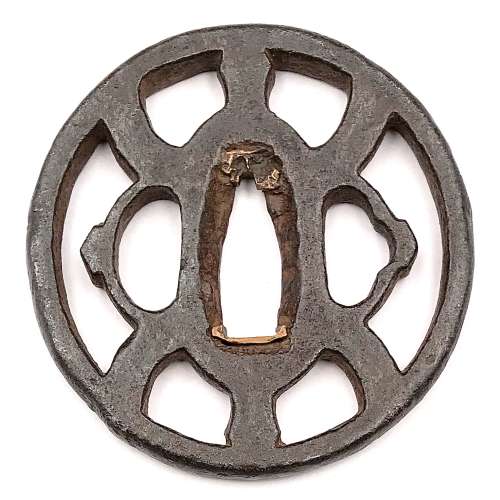 Iron tsuba of round form with design of the Chinese character for cinnabar (shu-no-ji) in openwork (sukashi). Round-cornered rim. Copper sekigane. Kanayama school. Early Edo period: Early 17th century (Kan-ei era). Height: 70.0 mm. Width: 69.6 mm. Rim thickness: 6.8 mm. Center thickness: 5.8 mm. Provenance: Sasano Masayuki Collection, № 139: "Many areas have a coarse texture and strong tekkotsu, with the thickness of the metal graduating from the rim to the seppa-dai. The combined color of the iron and motif date this work to the early Edo period".
Iron tsuba of round form with design of the Chinese character for cinnabar (shu-no-ji) in openwork (sukashi). Round-cornered rim. Copper sekigane. Kanayama school. Early Edo period: Early 17th century (Kan-ei era). Height: 70.0 mm. Width: 69.6 mm. Rim thickness: 6.8 mm. Center thickness: 5.8 mm. Provenance: Sasano Masayuki Collection, № 139: "Many areas have a coarse texture and strong tekkotsu, with the thickness of the metal graduating from the rim to the seppa-dai. The combined color of the iron and motif date this work to the early Edo period". -
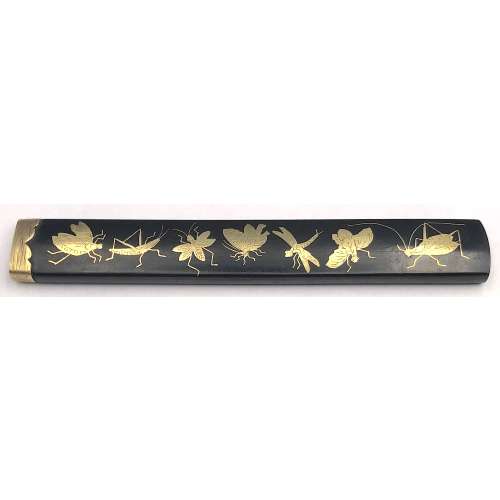 Kozuka with seven insects (fly, grasshopper, bee, butterfly, dragonfly, firefly, and cricket) and grass with dewdrops motif. Shakudō, flush gold inlay (hira-zōgan). 95.2 (H) x 13.7 mm (W). Mid Edo period (Late 17th - early 18th century, Genroku era 1688-1703). Unsigned. Kaga school. A look-a-like kozuka (with five insects) is illustrated at Japanese Sword Fittings. A descriptive catalogue of the Collection of G.H. Naunton, Esq., completed and illustrated by Henri L. Joly, - 1912 on plate XXIX, №691 [LIB-1389 in this Collection] with the following description at page 54: "Shakudō, inlaid with butterfly, dragon-fly, grasshopper, locust and another insect, gold."
Kozuka with seven insects (fly, grasshopper, bee, butterfly, dragonfly, firefly, and cricket) and grass with dewdrops motif. Shakudō, flush gold inlay (hira-zōgan). 95.2 (H) x 13.7 mm (W). Mid Edo period (Late 17th - early 18th century, Genroku era 1688-1703). Unsigned. Kaga school. A look-a-like kozuka (with five insects) is illustrated at Japanese Sword Fittings. A descriptive catalogue of the Collection of G.H. Naunton, Esq., completed and illustrated by Henri L. Joly, - 1912 on plate XXIX, №691 [LIB-1389 in this Collection] with the following description at page 54: "Shakudō, inlaid with butterfly, dragon-fly, grasshopper, locust and another insect, gold." See also tsuba TSU-0211 in this collection:
See also tsuba TSU-0211 in this collection:


-
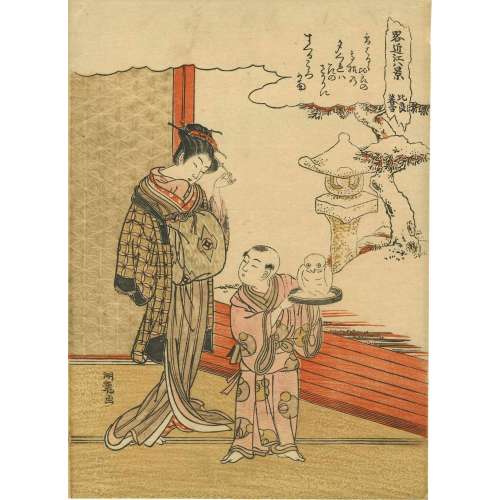 Evening Snow on Mount Hira (Hira no bosetsu), from the series Eight Views of Ōmi in Modern Guise (Ryaku Ōmi hakkei, (略近江八景). About 1773–75 (An'ei 2–4). Artist: Isoda Koryūsai (Japanese, 1735–1790) CATALOGUE RAISONNÉ: Hockley 2003, p. 202, #F-21-1 DIMENSIONS: Vertical chûban; 26 x 19.3 cm (10 1/4 x 7 5/8 in.)Signed: Koryû ga [湖竜画]
Evening Snow on Mount Hira (Hira no bosetsu), from the series Eight Views of Ōmi in Modern Guise (Ryaku Ōmi hakkei, (略近江八景). About 1773–75 (An'ei 2–4). Artist: Isoda Koryūsai (Japanese, 1735–1790) CATALOGUE RAISONNÉ: Hockley 2003, p. 202, #F-21-1 DIMENSIONS: Vertical chûban; 26 x 19.3 cm (10 1/4 x 7 5/8 in.)Signed: Koryû ga [湖竜画] -
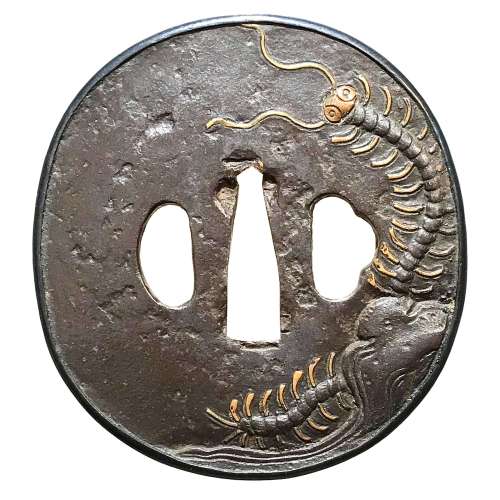
Iron tsuba of oval form with a shakudō fukurin and rough surface decorated by low relief carving and brass inlay with a centipede emerging from under the rock on both sides.
Edo period.Size: 78.9 x 73.6 x 3.8 mm
Unsigned. However, this tsuba may be (though with reservation) attributed to Misumi Kōji school. There is some information regarding this master(s) in Tsuba. An aesthetic study by Kazutaro Torigoye and Robert E. Haynes (from the Tsuba Geijutsu-kō of Kazataro Torigoye. Edited and published by Alan L. Harvie for the Nothern California Japanese Sword Club, 1994-1997) on pages 163-4, though I was not able to locate the tsuba in the original publication. Possibly, this fragment of the book was added by Robert Haynes. Markus Sesko speculates about Misumi in his The Japanese toso-kinko Schools.// Lulu Inc., 2012 on pages 374-5: "Misumi Kōjo Tsuba. Iron plate, elliptical shape, shakudō takabori suemon, yamagane fukurin. Centipede." But of course, visual similarity does not prove anything. I was not able to find any traces of signature or a triangle on the seppa-dai.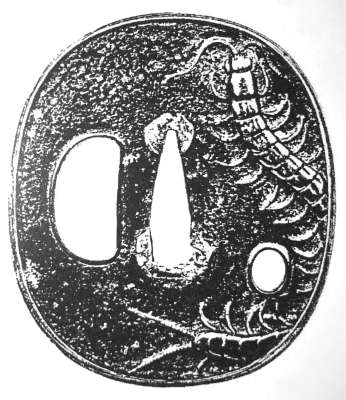
Misumi Kōji Tsuba on p. 163.
-
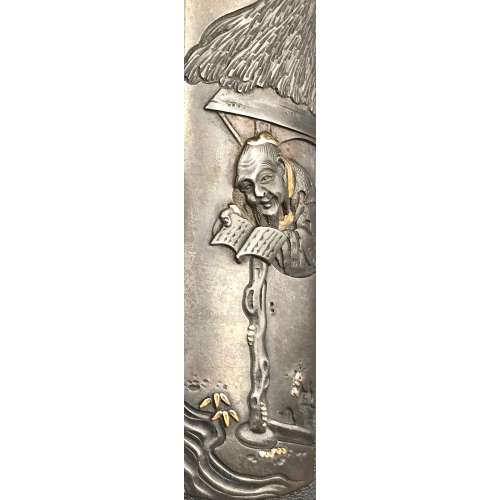 Shibuichi Kozuka carved in low relief (takabori, usuniku-bori) and inlaid in gold and silver with design of Shoko, reading by moonlight, thatch, pine rosettes, and fool moon. According to Henri L. Joly [LEGEND IN JAPANESE ART. London, 1908; LIB-1416 in this collection] Shoko was a Chinese student of Taoism who was so poor that he had no money to buy illuminating materials and read by moonlight. Shoko mentioned in the article about another Chinese character - Shaen, who was reading by the light emitted by glow-worms (see page 310). Signed on the back: Haruchika (春親) + kaō. Size: 97.3 mm (H) x 14.8 mm (W). Edo period, mid 19th century. NBTHK Certificate № 449542. Hamano Haruchika from Edo was a student of Haruyuki in 1848-54; Hamano School, Etchū Toyama Branch, according to M. Sesko's "Genealogy", page. 34. Most probably it is his work. Following the MFA data, it is also possible that "our" Haruchika is indeed Nara Haruchika or Tsuchiya Haruchika from Nara School; though I did not hind such artist in Markus Sesko books. However, in his "Toso-Kinko" on page 177 there is certain Shingorō who carried out his business under the name of Yanagawa Haruchika (1791-1857?)
Shibuichi Kozuka carved in low relief (takabori, usuniku-bori) and inlaid in gold and silver with design of Shoko, reading by moonlight, thatch, pine rosettes, and fool moon. According to Henri L. Joly [LEGEND IN JAPANESE ART. London, 1908; LIB-1416 in this collection] Shoko was a Chinese student of Taoism who was so poor that he had no money to buy illuminating materials and read by moonlight. Shoko mentioned in the article about another Chinese character - Shaen, who was reading by the light emitted by glow-worms (see page 310). Signed on the back: Haruchika (春親) + kaō. Size: 97.3 mm (H) x 14.8 mm (W). Edo period, mid 19th century. NBTHK Certificate № 449542. Hamano Haruchika from Edo was a student of Haruyuki in 1848-54; Hamano School, Etchū Toyama Branch, according to M. Sesko's "Genealogy", page. 34. Most probably it is his work. Following the MFA data, it is also possible that "our" Haruchika is indeed Nara Haruchika or Tsuchiya Haruchika from Nara School; though I did not hind such artist in Markus Sesko books. However, in his "Toso-Kinko" on page 177 there is certain Shingorō who carried out his business under the name of Yanagawa Haruchika (1791-1857?) -
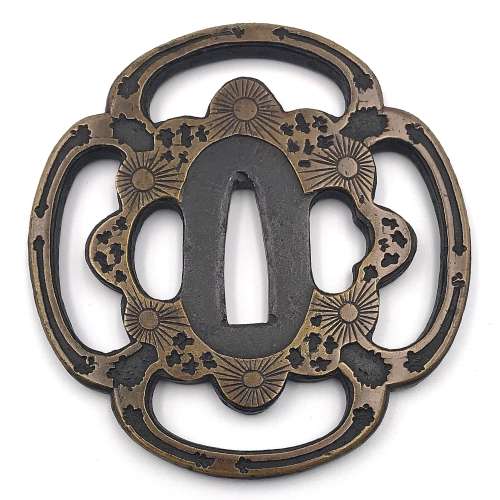
Iron tsuba of mokkō form (mokkōgata) pierced (sukashi) and inlaid with precast dark brass inlay (taka-zōgan) with somewhat abstract/geometrical design that can be liberally described as pines, mist, and snow.
Momoyama or early Edo period. End of the 16th - beginning of the 17th century. Heianjō school. Unsigned. Dimensions: 86.8 x 82.9 x 4.5 mm. -
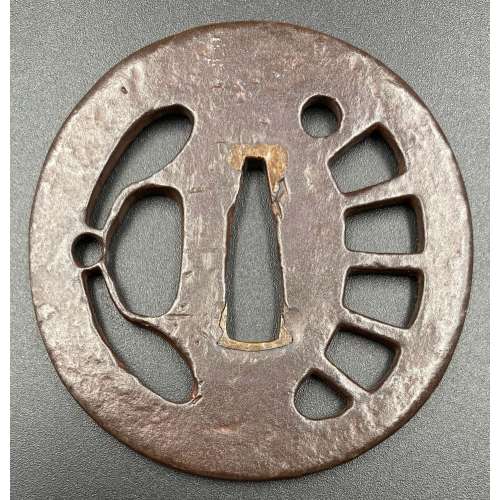
Oblong round shape (nagamaru-gata) tsuba with design of dragonfly (tombo or katsumushi) and wheel (kuruma) in negative openwork (kage-sukashi), round rim (maru-mimi ). Copper sekigane.
Okamoto Yasukazu's Owari to Mikawa no tankō, №181 characterizes the tsuba as follows: "Katsumushi, kuruma-sukashi no zu (dragonfly and wheel sukashi). Mei: Yamakichibei (Shodai). Such small tsuba are rare for the Shodai. The nakago-ana is also small so it was probably intended to be mounted on a tantō. Regardless of its size, the iron is outstanding and the workmanship shows the characteristic features of the Shodai (first generation). The kuruma-sukashi design is interpreted here in a half-moon shape and only on one side of the tsuba. Such a design is also seen on works of the Nidai (second generation)...". Signed to the left of nakaga-ana: Yamakichibei (山吉兵へ). Attributed to the First Generation (Shodai) master.
NBTHK paper (translated by Markus Sesko): The Tokubetsu-Kichō Kodōgu. Kachimushi-kuruma sukashi-tsuba (勝虫車透鐔) - Tsuba with sukashi motif of dragonfly and cartwheel. Signed: Yamakichibei (山吉兵). Iron, marugata, ko-sukashi. Issued on April 1, 1977. [Copy only] Dimensions: H: 66 mm; W: 63.2 mm; Th(center): 3.8 mm; Th(rim): 3.5 mm. Weight: 68 g. -
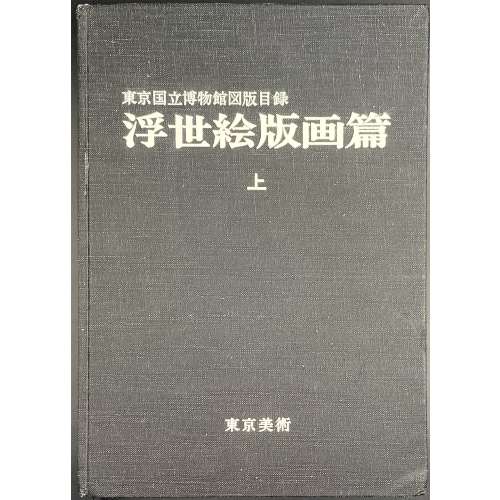 Title: Illustrated Catalogues of Tokyo National Museum: Ukiyo-e Prints [東京国立博物館図版目録 | 浮世絵版画編] (Tōkyō Kokuritsu Hakubutsukan zuhan mokuroku | Ukiyoe hanga hen); Publisher: Tokyo National Museum [東京国立博物館] (Tōkyō Kokuritsu Hakubutsukan). Three volumes, 26.3 x 18.7 cm, uniformly bound in black cloth with white characters to front cover and spine. Title-page: ILLUSTRATED CATALOGUES OF | TOKYO NATIONAL MUSEUM | UKIYO-E PRINTS | <1 (2, 3) > | 東京国立博物館図版目録 | 浮世絵版画編 | < 上 (中, 下) > || Volume 1 [上]: unpaginated 1 t.p., 2 colour plates, 1 contents, 70 (1-1354) – b/w plates, 1 + 48 paginated leaves (1-95 [96]) – text. Volume 2 [中]: unpaginated 1 t.p., 2 colour plates, 1 contents, 67 (1355-2493) – b/w plates + 33 paginated leaves (1-65 [66]) – text. Volume 3 [下]: unpaginated 1 t.p., 2 colour plates, 1 contents, 83 (2494-3926) – b/w plates + 35 paginated leaves (1-69 [70]) – text. Black and white photomechanical reproduction of almost four thousand woodblock prints with titles by the artist and in chronological order.
Title: Illustrated Catalogues of Tokyo National Museum: Ukiyo-e Prints [東京国立博物館図版目録 | 浮世絵版画編] (Tōkyō Kokuritsu Hakubutsukan zuhan mokuroku | Ukiyoe hanga hen); Publisher: Tokyo National Museum [東京国立博物館] (Tōkyō Kokuritsu Hakubutsukan). Three volumes, 26.3 x 18.7 cm, uniformly bound in black cloth with white characters to front cover and spine. Title-page: ILLUSTRATED CATALOGUES OF | TOKYO NATIONAL MUSEUM | UKIYO-E PRINTS | <1 (2, 3) > | 東京国立博物館図版目録 | 浮世絵版画編 | < 上 (中, 下) > || Volume 1 [上]: unpaginated 1 t.p., 2 colour plates, 1 contents, 70 (1-1354) – b/w plates, 1 + 48 paginated leaves (1-95 [96]) – text. Volume 2 [中]: unpaginated 1 t.p., 2 colour plates, 1 contents, 67 (1355-2493) – b/w plates + 33 paginated leaves (1-65 [66]) – text. Volume 3 [下]: unpaginated 1 t.p., 2 colour plates, 1 contents, 83 (2494-3926) – b/w plates + 35 paginated leaves (1-69 [70]) – text. Black and white photomechanical reproduction of almost four thousand woodblock prints with titles by the artist and in chronological order. -
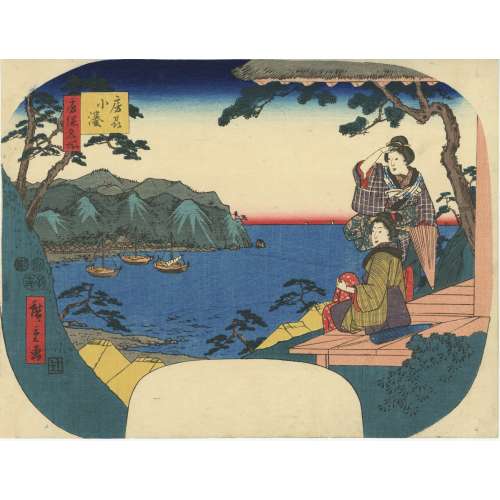 Kominato in Awa province (Bōshū Kominato) [房州小淡] – one of five fan prints in the series Famous places in the Bōsō peninsula (Bōsō meisho) [房粉名所], devoted to the trip undertaken by Hiroshige in 1852 to Bōsō peninsula (present-day Chiba prefecture). “Two fashionably dressed women beside the veranda of a wayside inn gaze out over Uchiura Bay toward the Tanjō Temple on the far shore as a boat sets out to the sea from the fishing hamlet of Kominato. …Hiroshige’s viewpoint is from the lower slopes of Mount Kiyosumi” (Izzard, 2020). Reference: (1) [LIB-2398.2020] Sebastian Izzard. Important Japanese Prints 1830–1860 March 14–20, 2020 exhibition, №. 52. (2) Christophe Marquet. Hiroshige: Les éventails d'Edo / Estampes de la collection Georges Leskowicz. — Paris: In fine, 2022, № 30, p. 94. Artist: Utagawa Hiroshige [歌川 広重] a.k.a. Andō Hiroshige [安藤 広重] (Japanese, 1797 – 1858). Signed: Hiroshige ga [広重 画] in a red cartouche. Publisher: Iseya Ichiemon 伊勢屋市右衛門] (Japanese, c. 1823 – 1864); seal Kaku-Tsuji 角辻 / Marks 16-023|143a. Date seal and double nanushi censor seal: Mera & Watanabe [米良 & 波邊]; Kaei 5, 12th month of the year of the Rat (1852). Dimensions: Fan print (Aiban yoko-e uchiwa-e); 225 x 292 mm.
Kominato in Awa province (Bōshū Kominato) [房州小淡] – one of five fan prints in the series Famous places in the Bōsō peninsula (Bōsō meisho) [房粉名所], devoted to the trip undertaken by Hiroshige in 1852 to Bōsō peninsula (present-day Chiba prefecture). “Two fashionably dressed women beside the veranda of a wayside inn gaze out over Uchiura Bay toward the Tanjō Temple on the far shore as a boat sets out to the sea from the fishing hamlet of Kominato. …Hiroshige’s viewpoint is from the lower slopes of Mount Kiyosumi” (Izzard, 2020). Reference: (1) [LIB-2398.2020] Sebastian Izzard. Important Japanese Prints 1830–1860 March 14–20, 2020 exhibition, №. 52. (2) Christophe Marquet. Hiroshige: Les éventails d'Edo / Estampes de la collection Georges Leskowicz. — Paris: In fine, 2022, № 30, p. 94. Artist: Utagawa Hiroshige [歌川 広重] a.k.a. Andō Hiroshige [安藤 広重] (Japanese, 1797 – 1858). Signed: Hiroshige ga [広重 画] in a red cartouche. Publisher: Iseya Ichiemon 伊勢屋市右衛門] (Japanese, c. 1823 – 1864); seal Kaku-Tsuji 角辻 / Marks 16-023|143a. Date seal and double nanushi censor seal: Mera & Watanabe [米良 & 波邊]; Kaei 5, 12th month of the year of the Rat (1852). Dimensions: Fan print (Aiban yoko-e uchiwa-e); 225 x 292 mm. -
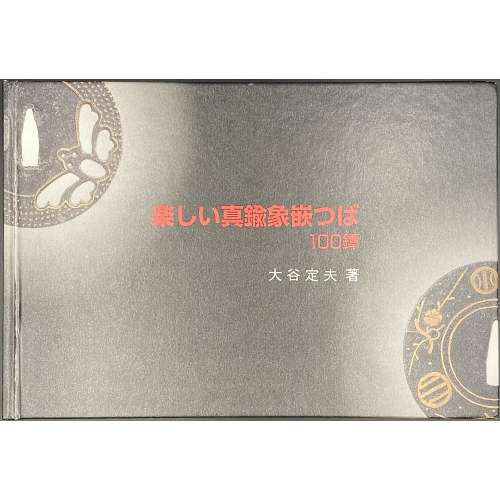 Description: Hardcover oblong volume 16 x 23.3 cm with black pictorial paper boards lettered in red and white to front cover and spine, in an ochre slipcase sprinkled brown and lettered in black to front and spine; grey endpapers, pp. [2] 3-130 [2], with a bookshop ticket to back pastedown “ISSHINDō”. Illustrated descriptions of 100 Japanese sword handguards (tsuba) with brass inlay. Title-page: 楽しい真鍮象嵌つば | 100 鐔 | 大谷定夫著 [Tanoshii Shinchū-Zōgan Tsuba | Hyakutan | Ōya Sadao cho] (Enjoying Brass Inlay Sword Guards | 100 Sword Guards | Author: Ōya Sadao) Colophon: Published December 15, 1999 Price: ¥3,800 (base price ¥3,619) Author: Ōya Sadao (大谷定夫) Producer: Ōtsuka Kōgeisha International Publisher: Ōtsuka Kōgeisha Co. Ltd. (大塚工藝社)Phone 103–0016 Tōkyō-to, Chūō-ku, Nihonbashi Koami-chō 1–5 Tel. 03–5642–3511 (Representative) Fax 03–5642–3618 Design: Takahashi Tōru (高橋享) Photography: Kitami Noboru (北見登) Kishioka Yasuhiro (岸岡保弘) ISBN4–900298–03–4 C0072 ¥3619E Subject: Ōnin tsuba; Heianjō tsuba; Suemon-zōgan; Ten-zōgan; Japanese sword handguards; Japanese sword fittings; Tosogu.
Description: Hardcover oblong volume 16 x 23.3 cm with black pictorial paper boards lettered in red and white to front cover and spine, in an ochre slipcase sprinkled brown and lettered in black to front and spine; grey endpapers, pp. [2] 3-130 [2], with a bookshop ticket to back pastedown “ISSHINDō”. Illustrated descriptions of 100 Japanese sword handguards (tsuba) with brass inlay. Title-page: 楽しい真鍮象嵌つば | 100 鐔 | 大谷定夫著 [Tanoshii Shinchū-Zōgan Tsuba | Hyakutan | Ōya Sadao cho] (Enjoying Brass Inlay Sword Guards | 100 Sword Guards | Author: Ōya Sadao) Colophon: Published December 15, 1999 Price: ¥3,800 (base price ¥3,619) Author: Ōya Sadao (大谷定夫) Producer: Ōtsuka Kōgeisha International Publisher: Ōtsuka Kōgeisha Co. Ltd. (大塚工藝社)Phone 103–0016 Tōkyō-to, Chūō-ku, Nihonbashi Koami-chō 1–5 Tel. 03–5642–3511 (Representative) Fax 03–5642–3618 Design: Takahashi Tōru (高橋享) Photography: Kitami Noboru (北見登) Kishioka Yasuhiro (岸岡保弘) ISBN4–900298–03–4 C0072 ¥3619E Subject: Ōnin tsuba; Heianjō tsuba; Suemon-zōgan; Ten-zōgan; Japanese sword handguards; Japanese sword fittings; Tosogu. -
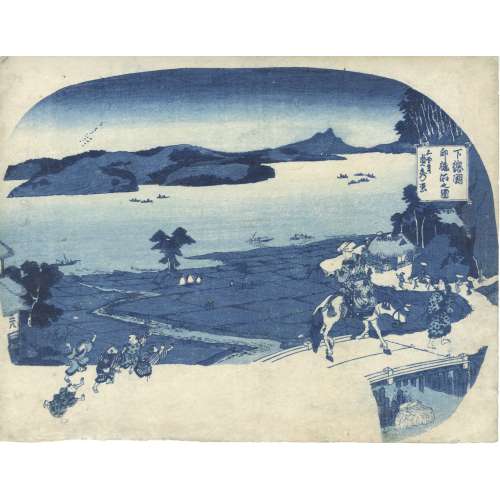 An uncut aizuri fan print showing travellers arriving at Inba Lake [印旛沼] (Inba-numa) on Shimosa Plateau [下総台地] (Shimōsa-daichi). Artist: Utagawa Sadahide [歌川貞秀] (Japanese, 1807 – 1879) Publisher: Unknown. Published: c. 1849. Signed: Gountei Sadahide ga [五雲亭 貞秀画] (Picture by Gountei Sadahide). Inscription in cartouche: Shimosa Plateau, Inbanuma (Inba Lake) [下總國印幡沼]. No date seal, no censor seal (privately printed?) Media: Fan print [団扇絵] (uchiwa-e), 235 x 300 mm.
An uncut aizuri fan print showing travellers arriving at Inba Lake [印旛沼] (Inba-numa) on Shimosa Plateau [下総台地] (Shimōsa-daichi). Artist: Utagawa Sadahide [歌川貞秀] (Japanese, 1807 – 1879) Publisher: Unknown. Published: c. 1849. Signed: Gountei Sadahide ga [五雲亭 貞秀画] (Picture by Gountei Sadahide). Inscription in cartouche: Shimosa Plateau, Inbanuma (Inba Lake) [下總國印幡沼]. No date seal, no censor seal (privately printed?) Media: Fan print [団扇絵] (uchiwa-e), 235 x 300 mm. -
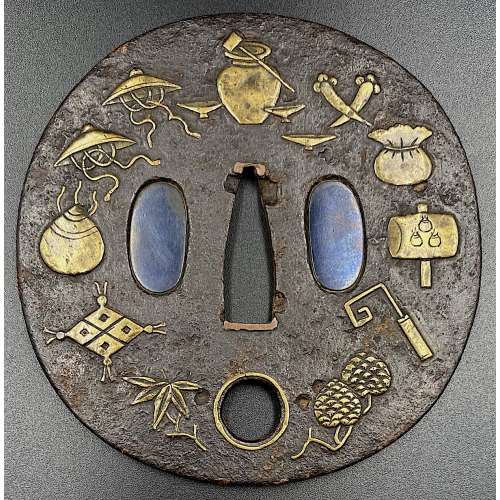 Iron tsuba of almost round form with a brass outlined circular opening (sukashi) in the bottom adorned with the Myriad Treasures [takaramono, 宝物] and winter motifs inlaid in cast brass (suemon-zōgan); hitsu-ana possibly cut later, both plugged with shakudo, nakaga-ana fitted with copper sekigane. According to Merrily Baird*) (2001), the symbolism of Myriad Treasures “is associated with the Seven Gods of Good Luck, who carry them in a sack”. Among the treasures, which are said to ensure prosperity, long life, and general good fortunes, are (reading clockwise from the top):
Iron tsuba of almost round form with a brass outlined circular opening (sukashi) in the bottom adorned with the Myriad Treasures [takaramono, 宝物] and winter motifs inlaid in cast brass (suemon-zōgan); hitsu-ana possibly cut later, both plugged with shakudo, nakaga-ana fitted with copper sekigane. According to Merrily Baird*) (2001), the symbolism of Myriad Treasures “is associated with the Seven Gods of Good Luck, who carry them in a sack”. Among the treasures, which are said to ensure prosperity, long life, and general good fortunes, are (reading clockwise from the top):- Sake set [shuki, 酒器], namely flask, ladle, and cups
- Cloves [choji, 丁子]
- Purse of inexhaustible reaches [kinchaku, 巾着]
- Magic mallet [kozuchi, 小槌]
- Key to the storehouse of the Gods [kagi, 鍵]
- Rhombus, or Lozenge (hosho, 方勝), with the second ideograph meaning victory.
- Sacred (or wish-granting) gem, or jewel [hōju, 宝珠]
- Hats of invisibility [kakuregasa, 隠れ笠]
-
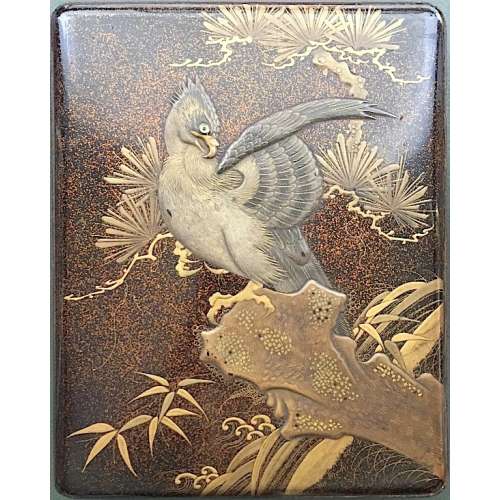 Japanese lacquer writing box (suzuribako) with an eagle sitting on a pine tree over the see waves. Rectangular box with rounded corners, slightly convex overlapping lid. Lacquer on wood with maki-e decoration in gold powder. The lid decorated inside with pine cones and needles over gold maki-e. Edo or Meiji period, 19th century.
Japanese lacquer writing box (suzuribako) with an eagle sitting on a pine tree over the see waves. Rectangular box with rounded corners, slightly convex overlapping lid. Lacquer on wood with maki-e decoration in gold powder. The lid decorated inside with pine cones and needles over gold maki-e. Edo or Meiji period, 19th century. -
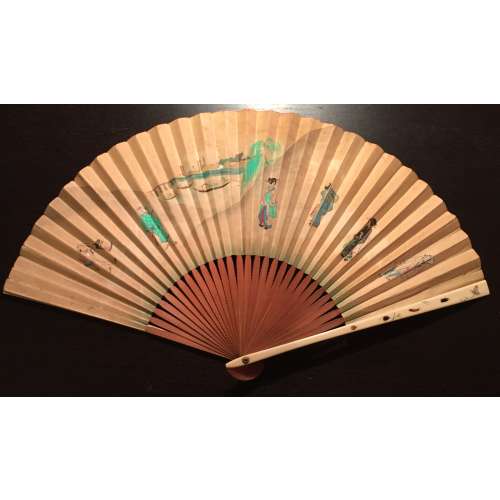 Late 19th-century (1850-1870) Japanese export fan. This fan has a double leaf painted with a different design on either side. Ivory encrusted with gemstones and other materials. Subject matter such as women wearing kimono is also more typical of export than domestic products (V&A). Summer (birds and flowers) theme on the reverse.
Late 19th-century (1850-1870) Japanese export fan. This fan has a double leaf painted with a different design on either side. Ivory encrusted with gemstones and other materials. Subject matter such as women wearing kimono is also more typical of export than domestic products (V&A). Summer (birds and flowers) theme on the reverse. -
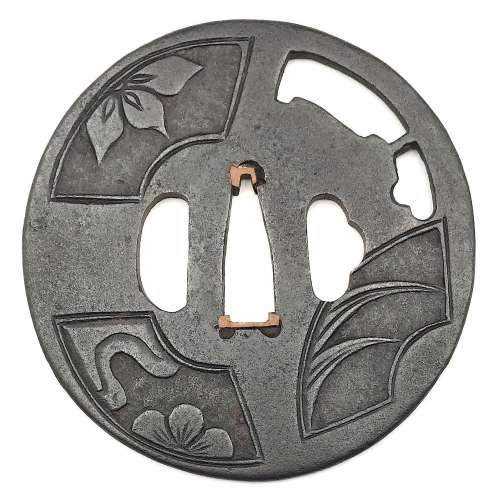 Iron tsuba of round form with design of hatchet executed in openwork (sukashi) and three fan panels motif on both sides carved in low relief (sukidashi-bori). Designs on the fan panels - face: bellflower, plum blossom in mist, grass leaves; - back: clouds, grass, and half plum blossom in mist. Copper sekigane. Koga-hitsu-ana probably cut out on a later date. Kamakura or kamakura-bori school. Edo period. Height: 83.8 mm, Width: 82.2 mm, Thickness at seppa-dai: 3.2 mm. NBTHK certificate № 4005500: Hozon (worthy of preservation).
Iron tsuba of round form with design of hatchet executed in openwork (sukashi) and three fan panels motif on both sides carved in low relief (sukidashi-bori). Designs on the fan panels - face: bellflower, plum blossom in mist, grass leaves; - back: clouds, grass, and half plum blossom in mist. Copper sekigane. Koga-hitsu-ana probably cut out on a later date. Kamakura or kamakura-bori school. Edo period. Height: 83.8 mm, Width: 82.2 mm, Thickness at seppa-dai: 3.2 mm. NBTHK certificate № 4005500: Hozon (worthy of preservation). -
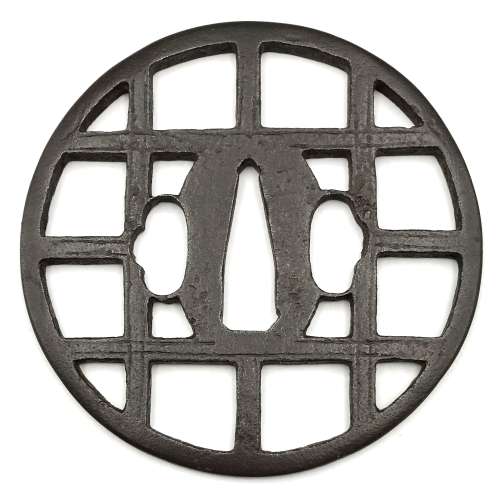 Iron tsuba of round form with design of lattice (kōshi-mon, 格子文) cut in openwork (sukashi), with low relief shallow linear carving along the bars. Well forged plate with brown-ish hue. To the right of nakago-ana there is a clear inscription of the character Shō (正), which is explained by Markus Sesko is follows: "The Shinsa obviously recognized more from the signature when having the tsuba in hand, i.e. they were confident to say it is signed "Shōami" but the rest is illegible (ika-fumei, 以下不明). That is, if they were just able to read the first character SHŌ (正) and saw that there were two more, most likely A (阿) and MI (弥), they would have put those character in boxes on the paper. Boxes around characters namely means that the character is not 100% legible but it can be assumed what it is." Momoyama or early Edo period. Dimensions: 85.9 mm diameter, 3.6 mm thickness at seppa-dai. Weight: 79 g. NBTHK certificate № 425069 with attestation: Hozon - "Worthy of preservation". A similar tsuba is presented at Japanese Sword Fittings from the R. B. Caldwell Collection. Sale LN4188 "HIGO". Sotheby's, 30th March 1994, №15. The description says: "A rare early Kamakura-bori tsuba. Nambokucho period (late 14th century). Of circular form, the dark plate carved and pierced with a gate design, the struts with double engraved lines. Unsigned. 8.5 cm." The lot was sold for 1,840 GBP.We have two possible explanations of the discrepancy between Sotheby's and Shinsa/Sesko attribution: 1) either Sotheby's or Shinsa/Sesko were wrong in their attribution or 2) these are two different pieces, one - Kamakura-bori from the 14th century and another - Shōami from 16th/17th century. Anyway, I would consider my piece as a Shōami tsuba of Momoyama - early Edo period, just for the sake of modesty.
Iron tsuba of round form with design of lattice (kōshi-mon, 格子文) cut in openwork (sukashi), with low relief shallow linear carving along the bars. Well forged plate with brown-ish hue. To the right of nakago-ana there is a clear inscription of the character Shō (正), which is explained by Markus Sesko is follows: "The Shinsa obviously recognized more from the signature when having the tsuba in hand, i.e. they were confident to say it is signed "Shōami" but the rest is illegible (ika-fumei, 以下不明). That is, if they were just able to read the first character SHŌ (正) and saw that there were two more, most likely A (阿) and MI (弥), they would have put those character in boxes on the paper. Boxes around characters namely means that the character is not 100% legible but it can be assumed what it is." Momoyama or early Edo period. Dimensions: 85.9 mm diameter, 3.6 mm thickness at seppa-dai. Weight: 79 g. NBTHK certificate № 425069 with attestation: Hozon - "Worthy of preservation". A similar tsuba is presented at Japanese Sword Fittings from the R. B. Caldwell Collection. Sale LN4188 "HIGO". Sotheby's, 30th March 1994, №15. The description says: "A rare early Kamakura-bori tsuba. Nambokucho period (late 14th century). Of circular form, the dark plate carved and pierced with a gate design, the struts with double engraved lines. Unsigned. 8.5 cm." The lot was sold for 1,840 GBP.We have two possible explanations of the discrepancy between Sotheby's and Shinsa/Sesko attribution: 1) either Sotheby's or Shinsa/Sesko were wrong in their attribution or 2) these are two different pieces, one - Kamakura-bori from the 14th century and another - Shōami from 16th/17th century. Anyway, I would consider my piece as a Shōami tsuba of Momoyama - early Edo period, just for the sake of modesty.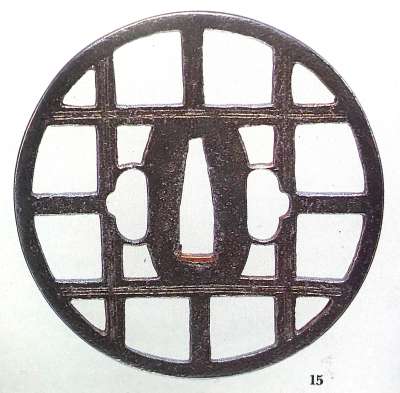
Caldwell Collection. Sotheby's 1994, №15.
-
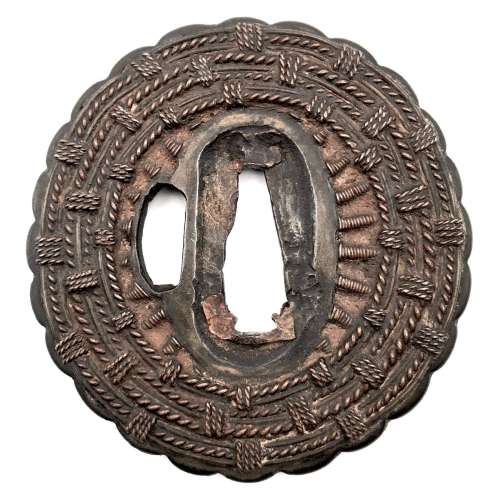 Tsuba of chrysanthemoid form (kikka-gata) with yamagane core and woven copper wire pattern. Copper sekigane. Shingen school. Height: 70.2 mm; Width 67.2 mm; Thickness at seppa-dai: 3.4-3.6 mm, overall 7.3 mm. Weight 82.7 g Inscription on the wooden box reads: "Muromachi period Mumei Zōgan Shingen Tsuba" Muromachi period, 16th century. Age attribution is based on the fact that the core is made of yamagane; later copies of Edo period are usually made of iron. This small and light tsuba was likely mounted on a combat sword, while larger and much heavier woven wire Shingen tsuba of Edo period were of purely decorative purpose. http://varshavskycollection.com/shingen-tsuba/
Tsuba of chrysanthemoid form (kikka-gata) with yamagane core and woven copper wire pattern. Copper sekigane. Shingen school. Height: 70.2 mm; Width 67.2 mm; Thickness at seppa-dai: 3.4-3.6 mm, overall 7.3 mm. Weight 82.7 g Inscription on the wooden box reads: "Muromachi period Mumei Zōgan Shingen Tsuba" Muromachi period, 16th century. Age attribution is based on the fact that the core is made of yamagane; later copies of Edo period are usually made of iron. This small and light tsuba was likely mounted on a combat sword, while larger and much heavier woven wire Shingen tsuba of Edo period were of purely decorative purpose. http://varshavskycollection.com/shingen-tsuba/ -
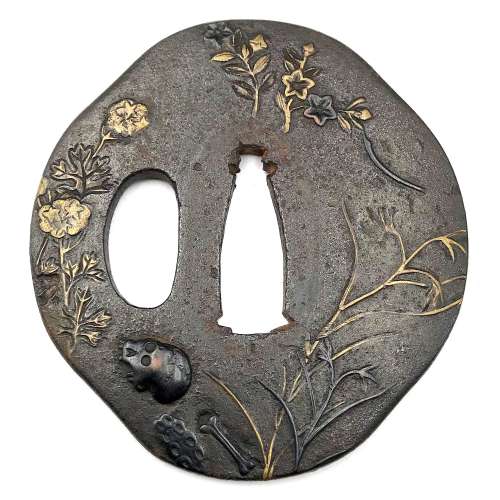 Iron tsuba of otafuku-gata form decorated on the face with death and autumn motifs: autumnal grasses and flowers in yellow brass and shakudō, skull, limb bone and sternum inlaid in shakudō. On the reverse the plate is inlaid in red copper with a chrysanthemum and maple leaves floating in stylized water streams. "Plants floating atop water form common motifs, as occurs with chrysanthemums, maple leaves, and cherry blossoms, in particular." [Merrily Baird]. Such plants may be used as a family crest (mon), or may be just a reminder of a floating nature of life. Momoyama period, late 15th century. Dimensions: 75.3 x 69.9 x 4.3 mm.
Iron tsuba of otafuku-gata form decorated on the face with death and autumn motifs: autumnal grasses and flowers in yellow brass and shakudō, skull, limb bone and sternum inlaid in shakudō. On the reverse the plate is inlaid in red copper with a chrysanthemum and maple leaves floating in stylized water streams. "Plants floating atop water form common motifs, as occurs with chrysanthemums, maple leaves, and cherry blossoms, in particular." [Merrily Baird]. Such plants may be used as a family crest (mon), or may be just a reminder of a floating nature of life. Momoyama period, late 15th century. Dimensions: 75.3 x 69.9 x 4.3 mm.


